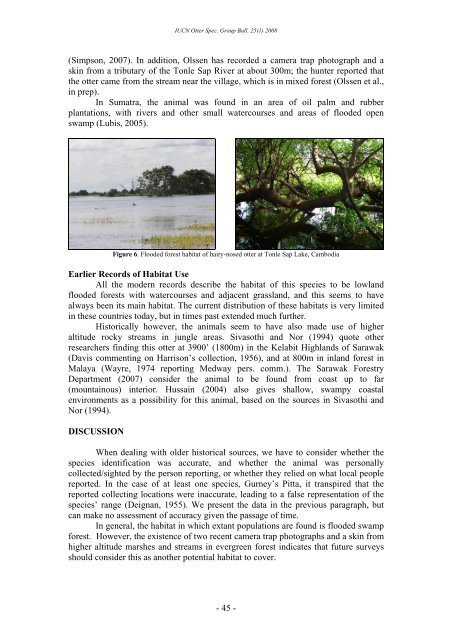IUCN <strong>Otter</strong> Spec. <strong>Group</strong> Bull. 25(1) 2008(Simpson, 2007). In addition, Olssen has recorded a camera trap photograph and askin from a tributary of the Tonle Sap River at about 300m; the hunter reported thatthe otter came from the stream near the village, which is in mixed forest (Olssen et al.,in prep).In Sumatra, the animal was found in an area of oil palm and rubberplantations, with rivers and other small watercourses and areas of flooded openswamp (Lubis, 2005).Figure 6. Flooded forest habitat of hairy-nosed otter at Tonle Sap Lake, CambodiaEarlier Records of Habitat UseAll the modern records describe the habitat of this species to be lowlandflooded forests with watercourses and adjacent grassland, and this seems to havealways been its main habitat. The current distribution of these habitats is very limitedin these countries today, but in times past extended much further.Historically however, the animals seem to have also made use of higheraltitude rocky streams in jungle areas. Sivasothi and Nor (1994) quote otherresearchers finding this otter at 3900’ (1800m) in the Kelabit Highlands of Sarawak(Davis commenting on Harrison’s collection, 1956), and at 800m in inland forest inMalaya (Wayre, 1974 reporting Medway pers. comm.). The Sarawak ForestryDepartment (2007) consider the animal to be found from coast up to far(mountainous) interior. Hussain (2004) also gives shallow, swampy coastalenvironments as a possibility for this animal, based on the sources in Sivasothi andNor (1994).DISCUSSIONWhen dealing with older historical sources, we have to consider whether thespecies identification was accurate, and whether the animal was personallycollected/sighted by the person reporting, or whether they relied on what local peoplereported. In the case of at least one species, Gurney’s Pitta, it transpired that thereported collecting locations were inaccurate, leading to a false representation of thespecies’ range (Deignan, 1955). We present the data in the previous paragraph, butcan make no assessment of accuracy given the passage of time.In general, the habitat in which extant populations are found is flooded swampforest. However, the existence of two recent camera trap photographs and a skin fromhigher altitude marshes and streams in evergreen forest indicates that future surveysshould consider this as another potential habitat to cover.- 45 -
IUCN <strong>Otter</strong> Spec. <strong>Group</strong> Bull. 25(1) 2008DIETIn Thailand, otter hunting behaviour was reported in the melaleuca forest. Theotters swim fast, frightening fish into the roots of plants, where they easily can becaught. They have been caught on camera traps raiding fish traps so skilfully that thefishermen never know they have been there (Kanchanasaka, 2007). In the dry season,they forage mainly in canals and remaining pools.In Viet Nam, Nguyen Xuan Dang (2005) found that the otters forage in all thehabitat types, but are more often observed foraging in the secondary melaleuca forest,especially in the canals and swampsIn Thailand, the main prey selected were three-spot gourami (Trichogastertrichopterus), common climbing perch (Anabas testudineus), and snakeheads(Channa sp) with some water snakes: fish were in >80% of scats and snakes in >10%(Kanchanasaka, 2001, 2007). This remained constant all year.In Viet Nam, in U Minh Thuong, they mainly took walking catfish (Clariusmacrocephalus), which are farmed, and snakeheads (Channa sp.) in the dry season. Ifno other fish are available, they will also take climbing perch and snakeskin gourami(Trichogastor pectoralis), which are scaly and less liked (Nguyen Vu Khoi et al.,2007, 2008). According to interviews with local people, this area used to haveabundant fresh-water crabs, but now due to salt water incursions, the crabs are nolonger present; during surveys in U Minh Ha National Park, the same author’s teamdid not observe any freshwater crabs in canals or forest. The local people commentedthat both Short-Clawed and Hairy-Nosed <strong>Otter</strong>s ate fish and snakes, which theyconsidered to be a change in diet resulting from the loss of the crab population.In both locations, they will also take small numbers of frogs, lizards, crabs,insects, birds and small mammals, as was found historically (see references inSivasothi and Nor, 1994).In Cambodia studies of prey species have not yet been carried out. However,given the proportion of water snakes in the diet of L. Sumatrana in Thailand it couldbe speculated that the large off-take of water snakes from Tonle Sap Lake (Stuart etal. 2000) could impact on the otters there.PREDATORS AND COMPETITORSMost of the animals that could prey on this species, e.g. leopards and tigers,have been reduced to extinction in its range by illegal hunting and habitat degradation.The hairy-nosed otter is probably the only large predator left in the areas where it isfound.In Thailand’s Tao Daeng peat forest, it is possible that cubs particularly mayfall prey to birds of prey such as the Grey-headed Fish-eagle (Ichthyopagaichthyaetus), which is known to take other water-dwelling animals such as turtles(Maheshwaran, 1994). Stray dogs may also be a problem as they penetrate the forestregularly. There may still be Reticulated Pythons in the area which may take cubs.In Viet Nam, eagles and Burmese Pythons (Python molurus) might prey onotters, but again all the major predators are gone.In the Tonle Sap Lake, Cambodia, the highly endangered Siamese Crocodile(Crocodylus siamensis), and and hybrids between it and C. porosus or C. rhombifer(frequently deliberately encouraged in crocodile farms with the inevitable escapes intothe wild according to Jelden et al, 2005), which pose, which pose a potential risk to- 46 -
















